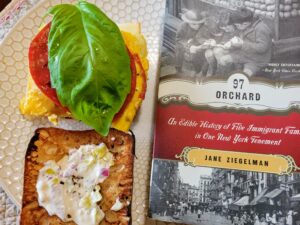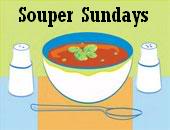Welcome to the latest round of Cook the Books. Simona of briciole is hosting 97 Orchard: An Edible History of Five Immigrant Families in One New York Tenement by Jane Ziegelman. About the Book:
About the Book:
 In 97 Orchard, Jane Ziegelman explores the culinary life that was the heart and soul of New York’s Lower East Side around the turn of the twentieth century—a city within a city, where Germans, Irish, Italians, and Eastern European Jews attempted to forge a new life. Through the experiences of five families, all of them residents of 97 Orchard Street, Ziegelman takes readers on a vivid and unforgettable tour, from impossibly cramped tenement apartments, down dimly lit stairwells, beyond the front stoops where housewives congregated, and out into the hubbub of the dirty, teeming streets. Ziegelman shows how immigrant cooks brought their ingenuity to the daily task of feeding their families, preserving traditions from home but always ready to improvise. 97 Orchard lays bare the roots of our collective culinary heritage.
In 97 Orchard, Jane Ziegelman explores the culinary life that was the heart and soul of New York’s Lower East Side around the turn of the twentieth century—a city within a city, where Germans, Irish, Italians, and Eastern European Jews attempted to forge a new life. Through the experiences of five families, all of them residents of 97 Orchard Street, Ziegelman takes readers on a vivid and unforgettable tour, from impossibly cramped tenement apartments, down dimly lit stairwells, beyond the front stoops where housewives congregated, and out into the hubbub of the dirty, teeming streets. Ziegelman shows how immigrant cooks brought their ingenuity to the daily task of feeding their families, preserving traditions from home but always ready to improvise. 97 Orchard lays bare the roots of our collective culinary heritage.
 About the author:
About the author:
Jane Ziegelman is the director of the Tenement Museum’s culinary center and the founder and director of Kids Cook!, a multiethnic cooking program for children. A James Beard Award winning food historian, her writing on food has appeared in numerous publications. She is the author of 97 Orchard: An Edible History of Five Immigrant Families in One New York Tenement and A Square Meal: A Culinary History of the Great Depression, which she wrote together with her husband, Andrew Coe. She also coauthored of Foie Gras: A Passion.
She lives in Brooklyn, New York.
What I thought…
I sometimes find myself having to slog through some non-fiction food writing. Give me a novel with a foodie slant and I am all there. (Even when it’s not a foodie novel, per se, I still look for food references as I read.)
After reading a few reviews of Ziegelman’s book, I was afraid 97 Orchard Street might be a trip on the struggle-bus. It was not. I enjoyed reading about the lives of the immigrants she profiles. Even though each section of the book focuses on a specific family, they really just become a generic composite of the families that inhabited the tenement (Irish-Catholic, Polish, Jewish, Germans, Italians). That is my only complaint with the book, I really wanted to know more about each family, more than just their date of immigration and how many children they had.
The most interesting part of the book was the description of the Ellis Island cafeteria. My ignorance of the immigrant experience became evident as I read about the feeding of thousands, fresh off the boat. I had no idea that the ship companies paid to feed the immigrants on Ellis Island and that they were fed so abundantly. But, my skeptical mind kept wondering if Zeigleman might be painting a rosier picture than the reality of the day. The immigrants, through food, were introduced to new customs and culinary ways in these cafeterias. Here the new Americans experienced a Thanksgiving meal with all the trimmings (131). According to Ziegelman, they were most taken with bananas and sandwiches, food that they had never before experienced. It was refreshing to note that they did try to cater a bit (when possible) to the immigrant groups. A Kosher kitchen was established but with a non-Kosher cook.
I also was intrigued by how the inhabitants of 97 Orchard adapted with the products that were available like the introduction of Crisco and it taking the place of schmaltz in some kitchens (118). In fact, some of Crisco’s advertising was directed specifically toward the Jewish housewife.
Zeigelman includes some recipes within the text. I was intrigued by a number of them but a few made a possible “to-make” list for this post including the following:
- Hasenpfeffer (11)
I have always been fascinated with this ever since Yosemite Sam tried to turn Bugs into a meal fit for a king. - Green Dumplings (12)
I was intrigued by this recipe for it’s use of spinach and spring herbs. - “Farmers Chop-Suey” (147)
This dish of chopped radishes, cucumbers, scallions and peppers was topped with cottage cheese. Total trivia: “This classic Jewish creation was reportedly the food that Harry Houdini (a Hungarian-born Jew) requested on his deathbed”(147) - Crocannte (206)
An almond brittle recipe from the 1919 The Italian Cook Book by Maria Gentile - Potatoes
Throughout, I noticed the part potatoes played in almost every culture mentioned.
Of course the Irish potato blight and the starvation which ensued was the reason many Irish found themselves on a new shore. Zeigelman states that the “Jews from Prussia, Posen, and all points east relied on potatoes. No people on earth could equal the Irish in potato consumption, but the Jews of Eastern Europe came close” (107). She includes recipes for Potato Kugel (109), Potato Pancakes (105), and Potato Puffs (110).
Potatoes were a long lasting commodity and could be relied upon to keep families from starvation, not only on the journey to America but also during their initial settlement. We have family friends whose grandparents immigrated to Canada from the Ukraine during the very early part of the 20th century. As family lore has it, as the family put down homesteading roots in the wilderness of Alberta, they actually slept with their potato seedlings to keep them from freezing. Otherwise, they would have starved the upcoming year with no potato crop. (You can read about this family and three others who made their way to North America in Quest for Eden: Ukrainians’ Quest for Paradise by John L. Woronuk.)
I knew I wanted to make something with potatoes and I recently came across a recipe for Potato, Chorizo, and Egg Sandwiches. Since the immigrants were fascinated by sandwiches upon their arrival, I decided to modify this recipe just a bit.
Potato Sandwiches with Pepperoni and Basil
Here’s a cross between a frittata, a tortilla Española, and a pizza.
Ingredients
- 1/2 c. mayonnaise
- 1/4 c. finely chopped pepperoncini peppers
- 1/2 c. red onion, chopped (divided)
- Kosher salt and freshly ground pepper
- 5 T. extra-virgin olive oil, divided
- 1 c. water
- 2 russet potatoes, peeled
- 3 oz. pepperonis (May use turkey pepperoni.)
- 8 large eggs
- slice of cheese (Muenster, Provolone, or Mozzarella)
- 4 ciabatta rolls, split and toasted
- Garnishes: large leaf basil and sliced tomatoe
Instructions
- Preheat oven to 375°F.
- Stir together mayonnaise, pepperoncini, and 2 tablespoons red onions; season with salt and pepper. Set aside.
- Take peeled potatoes and slice in half down the long side. Then slice into 1/4″ half-rounds. Set aside.
- In a medium skillet, bring 3 tablespoons oil, potatoes, and 1 cup water to a boil over medium heat; season. Boil, stirring occasionally, until potatoes are tender, 8 to 10 minutes. Add remaining onions and pepperoni. Cook, stirring, until onions are beginning to soften, about 1 minute.
- Whisk eggs in a large heatproof bowl; stir in potato mixture to combine. Season with salt and pepper. Wipe out skillet.
- Heat remaining 2 tablespoons oil in clean skillet over medium-high. Add egg mixture; cook, stirring to develop curds, about 1 minute. Transfer to oven; bake until just set, 10 to 13 minutes. Let cool 10 minutes. Run a rubber spatula around edges; slide onto a cutting board. Slice into squares.
- Toast the buns and then slather on the mayo mixture. Put a slice of cheese on the bottom roll. Top with slice of the potato/egg mixture. Layer on basil and tomato. Serve.
Yield: 4

Served with a side of sliced tomatoes.
The original recipe calls for Yukon gold potatoes, but I used plain old russet potatoes. I figured that was probably what was available to the book’s families. So here you go—my composite homage to all that lived at 97 Orchard. Even though Ziegelman didn’t mention a lot of potatoes in the Italian section of the book, I tried to include them here with the peppers, pepperonis, and basil.
These are truly knife and fork sandwiches. Pretty messy but delicious. They would be a great breakfast option.
I’m linking up to Foodies Read
and CTB co-host Deb’s Souper Sunday (with sammies and salad).
Our next Cook the Books selection is Midnight at the Blackbird Cafe by Heather Webber (July 2019) for the August / September 2021 edition. Deb (Kahakai Kitchen) is hosting. Please grab a copy and join us.

I’ve toured that tenement. Wow. That was some hard living back then. It was a great tour, but we’d had lunch with wine in Little Italy, and halfway through the tour I had to pee and I kind of made people mad trying to find the bathroom in the tour office next door. Ooops. the danger of drinking wine at lunch. This sandwich looks wonderful!
What? Did they not update the tenement to add a few public restrooms? What a story! 🙂
Your sandwich sounds delicious. I, too, had wished that there was more information about the families that she chose to write about.
I did enjoy the history lessons and I learned a lot…just not about those five familes.
wow this sounds delicious. i am very fond of sandwiches 🙂
You can put almost anything between bread and call it such.
I’m the opposite of you, reading wise — I find most modern fiction a slog (give me almost any 19th century novel and I’m in heaven, though) and find nonfiction more engaging. Weird, huh? What’s not weird is this sandwich. Wow, such a nice flavor combo. Thanks!
You might enjoy this one. I did…just wanted a bit more narrative about the families.
A very yummy sounding sandwich! I’m on the side that enjoyed getting to know a bit of history that was unfamiliar, even though a part of my own family’s past on both sides. I think the individual families were focused on only as a jumping point, and not meant to be their stories alone, but of the culture they came from.
I totally agree—but I guess I had a preconceived idea that there would be more narrative about them….I bet there were only so many records available and she would have had to conjecture otherwise.
I think the subtitle pointed to more about the families. Once I started the book, I realized they were a jumping point, as Claudia mentioned, representative of a larger story. You are right, Debra, that potatoes play a large role in the book, so great choice of recipe. Thank you so much for your contribution to this edition of Cook the Books 🙂
I enjoyed the book too. It took me a while to finish it because of work and life but it was very interesting. Your sandwich looks amazing–thanks for sharing it with Souper Sundays this week too! 😉
[…] North Face of the Heart. If you like culinary non-fiction in the food history genre, pick up 97 Orchard Street. I’m currently reading Mrs. Rochester’s Ghost by Lindsay Marcott and am enjoying it […]
I may still read this book even though I am too late to join in with CtB. I think I had the dates written down wrong, thinkning it closed in October.
Great sandwiches, verry creative.
That’s really funny that you always look for food references in books you read, non-fiction. Sounds like a great sandwich. Quite different from any I’ve had. I don’t think I’ve had a sandwich that has potatoes in it. Now I’m curious.